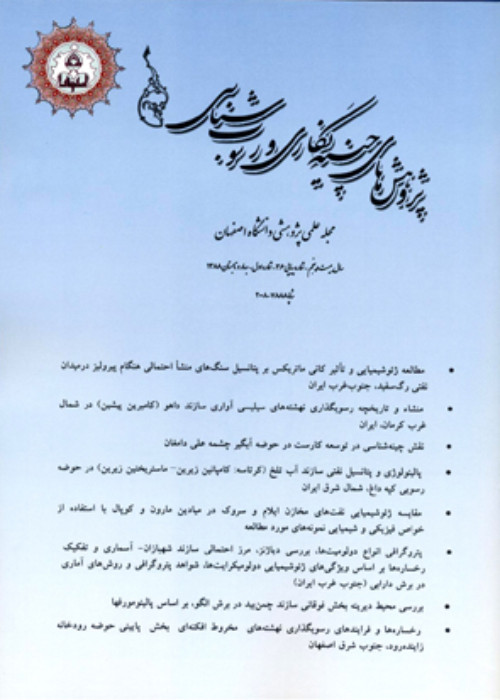Microfacies analysis and depositional environment of the Sarvak Formatiom in Tang-e Bawlak and Shahnakhjir sections, Malekshahi County, Ilam
Author(s):
Article Type:
Research/Original Article (دارای رتبه معتبر)
Abstract:
Introduction
The study area is located in the Zagros fold-thrust belt in which numerous amounts of hydrocarbon reserves are trapped in the Sarvak Formation (Cretaceous) and the Asmari Formation (Oligo-Miocene) (Mc Clay et al. 2011). The Sarvak Fm. is an important part of the Bangestan Group and laterally passes into the Garau Formation shales toward the Lorestan zone. Furthermore its lateral facies equivalents are well appreciated in the surrounding countries (i.e. the Madud and Mishrif formations in Kuwait, the Vasia Group in UAE, the Natih Formation in Oman, the Ahmadi, Madud and Rumayleh formations in Iraq and KSA (Alsharhan and Kendall 1991; Hajikazemi et al. 2010; Razin et al. 2010; Sadooni et al. 2005). Hence understanding any possible lateral changes of the Sarvak reservoir is crucial. The present study attempts to figure out such changes via examining microfacies characteristics and depositional environment of the Sarvak Fm.
Materials and Methods
Two exposed sections of the Sarvak Formation (Cretaceous) were studied in the Kabirkuh around the Malekshahi city in Ilam province named the Tange- Bawlak and Shahnakhjir sections. A total of 430 samples were collected. Detailed petrographic examinations on the stained thin sections were examined under routine petrographic microscope equipped by digital camera. All field evidences were also carefully recorded which will be briefly introduced in the following section.
Discussion of Results and Conclusion:
Examinations of thin sections revealed 17 microfacies in the Sarvak Fm. which were deposited in 5 distinct depositional settings including tidal flat, lagoon, bar, deep shelf and slope as well. These microfacies are:A-Tidal flat facies association composed of two microfacies barren lime mudstone and dolomitic fenestral packstones to bindstones.B-Lagoon facies association including peloid bioclast grainstone to packstone containes Nezzazata, Textularia, Murgina apula, Pseudolituonella reicheli, Gavelinella and mudstone to wackestone partially dolomitized with Miliolids and Nezzazata, Spiroplectinata annectene.
C-Shallow water bank, reefs and bars consist of 5 microfacies as allochthonous bioclastic rudstone, peloid bioclast rudstone, grainstone to packstone with large scale cross bedding, bioclastic rudstones with brachiopods shell concentration, glauconitic intraformational conglomerate, bioturbated bioclastic packstone to wackestones with Quinqueloculina, Vidalina, Dorothia, Muricohedbergella andmiliolid.
D-Intrshelf basin (shallow to deep subtidal) that caontain several microfacies such as spiculite wackestone - packstone with a calcisiltite matrix and/or fecal pellets, extensively burrowed bioclastic wackestone- floatstone, glauconitic wackestones and floatstones with infauna and epifauna whole fossils, Oligostegina wackestone with calcisiltite matrix.
E-slope and deep basin facies association that comprises thin-shelled planktonic bivalve (filaments) with intraclastwackestone, globotruncanid and calcisphere wackestone, microbreccia, bioclastic-lithoclastic packstone or rudstone.
Interpretations of these facies associations along with field evidences suggests that the depositional environment of the Sarvak Fm. were twofold including platform and deep foreland basin sediments. The platform margin was characterized by high-energy bar/barrier designated by large-scale cross bedding in grainstone and biogenic carbonate buildups. Sporadic turbidity currents probably were responsible to transport the shallow water carbonates into surrounding intrashelf basins. The intrashelf sediments are rich in planktonic biota interbedded with shale and marls rich in open marine fossils including brachiopods, echinoderms and ammonites. Seemingly, the platform setting uplifted as the consequence of Subhersinian orogeny. The unconformity was recognized by evidences such as brecciation, karstification and conglomeratic horizon.
Subsequent global sea level rise during Early Turonian brought a foreland basin in which about 106 m argillaceous thin to thick bedded limestones capped the interval of the Sarvak Fm. during Late Turonian. These deposits contain Helvetoglobotuncana helvetica, Clavihedbergella, Murginotruncana coronata, Whiteinella, Hedbergella, Rotalipora, Heterohelix, Margnotruncana renzi, Dorotha, Dicarinella.
The Sarvak Fm. is 845m and 412m thick in the Tange-e Bawlak and Shahnakhjir sections respectively. In the both sections it consists of two facies types including platform facies and foreland basin deposits. The platform deposits inturn composed of neritic (shallow water) sediments and platform margin high energy facies. The foreland basin are argillaceous and fine grained displaying evidences of pressure solution and are abouut 106 thick.
Keywords:
Language:
Persian
Published:
Stratigraphy and Sedimentology Researches, Volume:34 Issue: 2, 2018
Pages:
43 to 67
magiran.com/p1916937
دانلود و مطالعه متن این مقاله با یکی از روشهای زیر امکان پذیر است:
اشتراک شخصی
با عضویت و پرداخت آنلاین حق اشتراک یکساله به مبلغ 1,390,000ريال میتوانید 70 عنوان مطلب دانلود کنید!
اشتراک سازمانی
به کتابخانه دانشگاه یا محل کار خود پیشنهاد کنید تا اشتراک سازمانی این پایگاه را برای دسترسی نامحدود همه کاربران به متن مطالب تهیه نمایند!
توجه!
- حق عضویت دریافتی صرف حمایت از نشریات عضو و نگهداری، تکمیل و توسعه مگیران میشود.
- پرداخت حق اشتراک و دانلود مقالات اجازه بازنشر آن در سایر رسانههای چاپی و دیجیتال را به کاربر نمیدهد.
In order to view content subscription is required
Personal subscription
Subscribe magiran.com for 70 € euros via PayPal and download 70 articles during a year.
Organization subscription
Please contact us to subscribe your university or library for unlimited access!



